THE CONTEXT: The 2023 Nobel Prize in Physics has been awarded to Pierre Agostini, Ferenc Krausz, and Anne L’Huillier “for experimental methods that generate attosecond pulses of light for the study of electro dynamics in matter”. This article explains in detail the various aspects of the work of these Nobel laureates from the UPSC perspective.
THE NOBEL LAUREATES
The three Nobel Laureates in Physics 2023 are being recognised for their experiments, which have given humanity new tools for exploring the world of electrons inside atoms and molecules.
- Their work on the development of attosecond pulses of light has revolutionized our understanding of the fundamental processes of physics and chemistry. Attoseconds are extremely short units of time, one attosecond is equal to one billionth of a billionth of a second. Attosecond pulses of light are so short that they can be used to capture the motion of electrons inside atoms and molecules.
- Attosecond pulses of light allow scientists to see the motion of electrons in real time. This has led to a deeper understanding of a wide range of phenomena, including the dynamics of chemical reactions, the properties of materials, and the behavior of electrons in lasers.
- Attosecond science is still a young field, but it has the potential to revolutionize many areas of science and technology. For example, attosecond pulses of light could be used to develop new materials, improve the efficiency of solar cells, and create new medical imaging techniques.
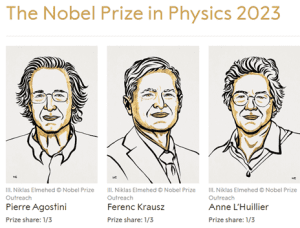
- Pierre Agostini (France):Professor, Ohio State University, USA
- Ferenc Krausz (Hungary): Professor, Ludwig-Maximilians-Universität, Germany
- Anne L’Huillier (France):Professor, Lund University, Sweden
NOBEL LAUREATES IN THE FIELD OF PHYSICS
| YEAR |
PERSON |
TOPIC |
| 2022 |
|
|
| 2021 |
|
|
| 2020 |
|
|
| 2019 |
|
|
| 2018 |
|
|
| 2017 |
|
|
| 2016 |
|
|
| 2015 |
|
|
| 2014 |
|
|
ABOUT ATTOSECOND
- An attosecond (as) is a unit of time equal to 1×10−18 of a second (one quintillionth of a second). It is the shortest unit of time that has been measured directly.
- Attoseconds are so short that they are difficult to comprehend. To put it in perspective, an attosecond is to a second what a second is to about 31.71 billion years.
- Attosecond pulses of light are even shorter. They can be as short as a few attoseconds, which means that they can be used to capture the motion of electrons inside atoms and molecules.
- It is a rapidly growing field with the potential to revolutionize our understanding of the fundamental processes of physics and chemistry. It has also the potential to lead to the development of new technologies, such as attosecond microscopes and attosecond lasers.
Attosecond pulses have been used to study a wide range of phenomena, including:
- The dynamics of chemical reactions
- The properties of materials
- The behavior of electrons in lasers
- The interactions between light and matter
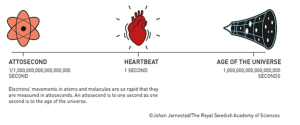
WHAT IS THE ATTOSECOND PULSES?
- It is extremely short pulses of light that last only a few attoseconds (one attosecond is equal to one quintillionth of a second). They are so short that they can be used to capture the motion of electrons inside atoms and molecules.
- It is generated using a variety of techniques, including high harmonic generation (HHG) and four-wave mixing (FWM). In HHG, a powerful laser pulse is focused onto a gas. The laser pulse ionizes the gas atoms, creating free electrons. The electrons are then accelerated by the laser field and interact with the gas atoms to produce high-energy photons. These photons are the attosecond pulses of light.
- In FWM, three laser pulses are focused onto a gas. The interaction of the three laser pulses produces a fourth laser pulse, which is the attosecond pulse.
WHAT ARE THE APPLICATIONS OF ATTOSECOND PHYSICS?
- It can be used to study the dynamics of chemical reactions and the properties of materials at the atomic and molecular level.
- It can be used to study the interaction of light with matter, which is essential for understanding how solar cells work.
- It can be used to develop new medical imaging techniques that can image biological systems at the atomic and molecular level.
- It can be used to study the behavior of electrons in quantum systems. This information could be used to develop new quantum computers that are much more powerful than conventional computers.
RESEARCH ON ATTOSECONDS
- It is providing shorter snapshots of atoms and molecules, attosecond spectroscopy has helped researchers understand electron behaviour in single molecules, such as how electron charge migrates and how chemical bonds between atoms breaks.
- The attosecond technology has been applied to studying how electrons behave in liquid water as well as electron transfer in solid-state semiconductors.
- As researchers continue to improve their ability to produce attosecond light pulses, they’ll gain a deeper understanding of the basic particles that make up matter.
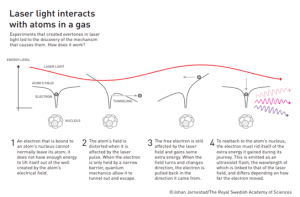
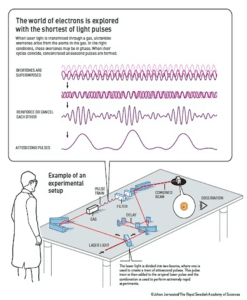
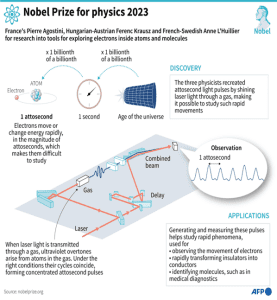
WHAT IS ELECTRON DYNAMICS?
- It is the study of the motion of electrons in atoms, molecules, materials, and devices. It is a field of physics that is concerned with the fundamental processes that govern the behavior of electrons, such as their interactions with other electrons, with light, and with the electromagnetic field.
- It is a very important field of physics, as it has many applications in other fields, such as chemistry, materials science, and electronics. For example, the understanding of electron dynamics is essential for the development of new materials, such as semiconductors and superconductors, and for the development of new electronic devices, such as transistors and lasers.
HOW DID SCIENTISTS ACHIEVE ATTOSECOND PULSE GENERATION?
- Scientists achieved attosecond pulse generation by developing new techniques to create and measure extremely short pulses of light. Attosecond pulses are pulses of light that last only a few attoseconds (one attosecond is equal to one quintillionth of a second). They are so short that they can be used to capture the motion of electrons inside atoms and molecules.
- One of the most common techniques for generating attosecond pulses is high harmonic generation (HHG). In HHG, a powerful laser pulse is focused onto a gas. The laser pulse ionizes the gas atoms, creating free electrons. The electrons are then accelerated by the laser field and interact with the gas atoms to produce high-energy photons. These photons are the attosecond pulses of light.
How high harmonic generation (HHG) works to generate attosecond pulses?
- A powerful laser pulse is focused onto a gas.
- The laser pulse ionizes the gas atoms, creating free electrons.
- The electrons are accelerated by the laser field and interact with the gas atoms to produce high-energy photons.
- These photons are the attosecond pulses of light.
THE CONCLUSION: In future the Nobel Prize in Physics will continue to recognize and reward groundbreaking research in attosecond physics, as well as other areas of physics that are essential for the universe and the development of new technologies. These areas include quantum mechanics, astrophysics, materials science, and climate science.
MAINS QUESTION
Q 1. Discuss the potential applications of attosecond physics in the development of advanced electronic devices and energy storage technologies.
Q 2. Describe the work for which the 2023 Nobel Prize in Physics was awarded. What implications does this work have for scientific and technological advancements?
UPSC CIVIL SERVICES EXAMINATION PREVIOUS YEAR QUESTION (PYQ)
Prelims
Q. Who among the following scientists shared the Nobel Prize in Physics with his son? (2008)
(a) Max Planck
(b) Albert Einstein
(c) William Henry Bragg
(d) Enrico Fermi
Ans: (c)
Q. Nobel Prize winning scientist James D. Watson is known for his work in which area? (2008)
(a) Metallurgy
(b) Meteorology
(c) Environmental protection
(d) Genetics
Ans: (d)
Mains
Q 1. The Nobel Prize in Physics of 2014 was jointly awarded to Akasaki, Amano and Nakamura for the invention of Blue LEDs in the 1990s. How has this invention impacted the everyday life of human beings? (2021)
Q 2. Discuss the work of ‘Bose-Einstein Statistics’ done by Prof. Satyendra Nath Bose and show how it revolutionized the field of Physics. (2018)
Spread the Word
